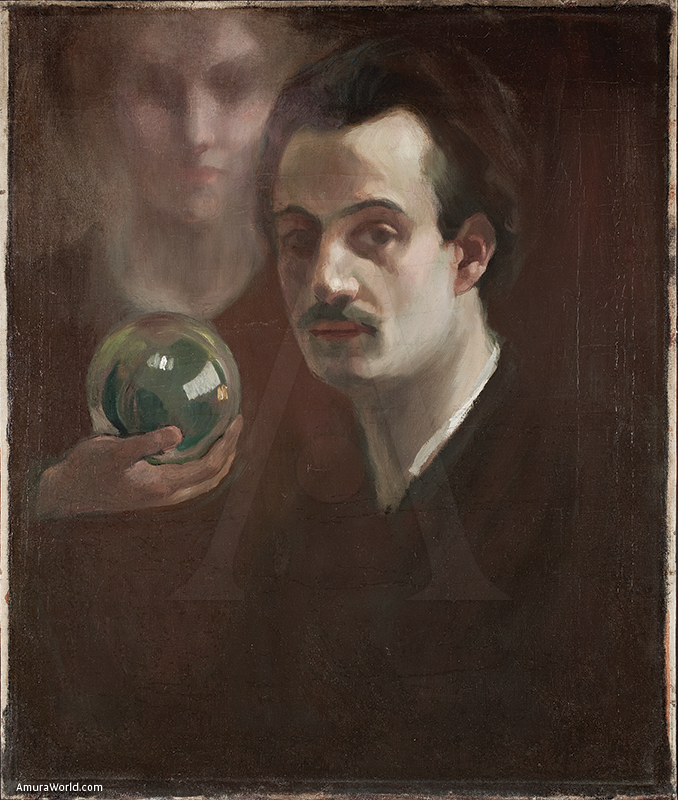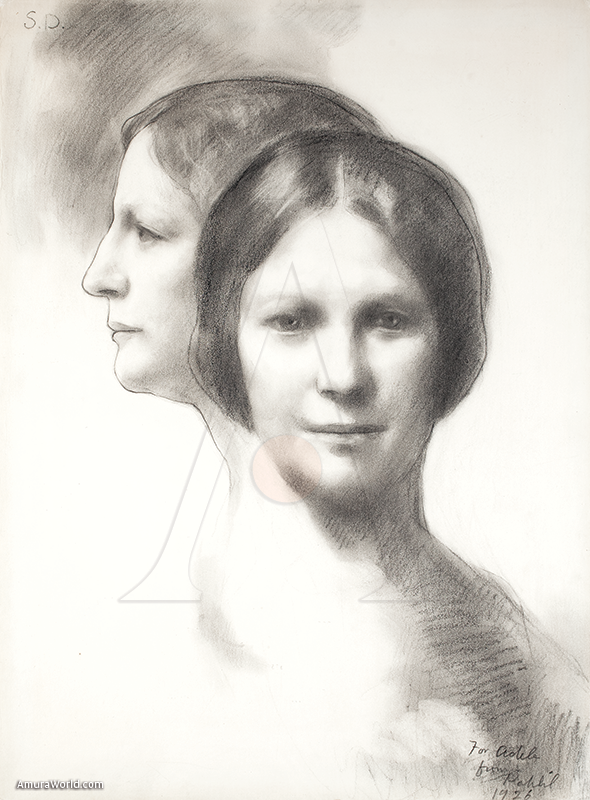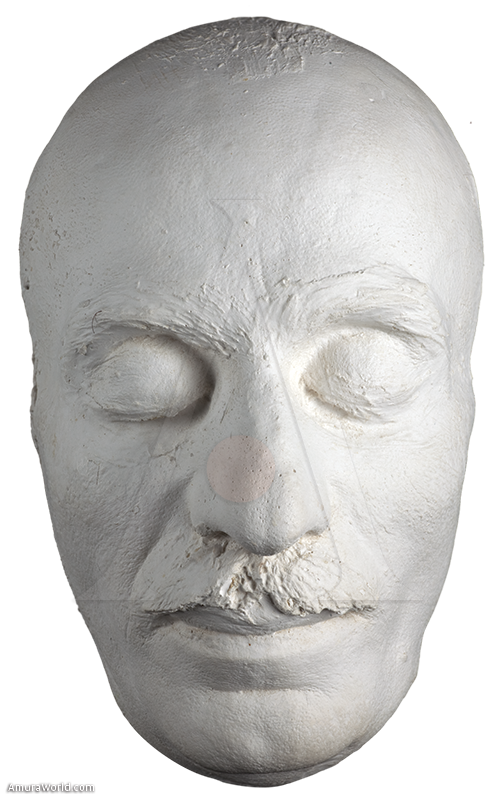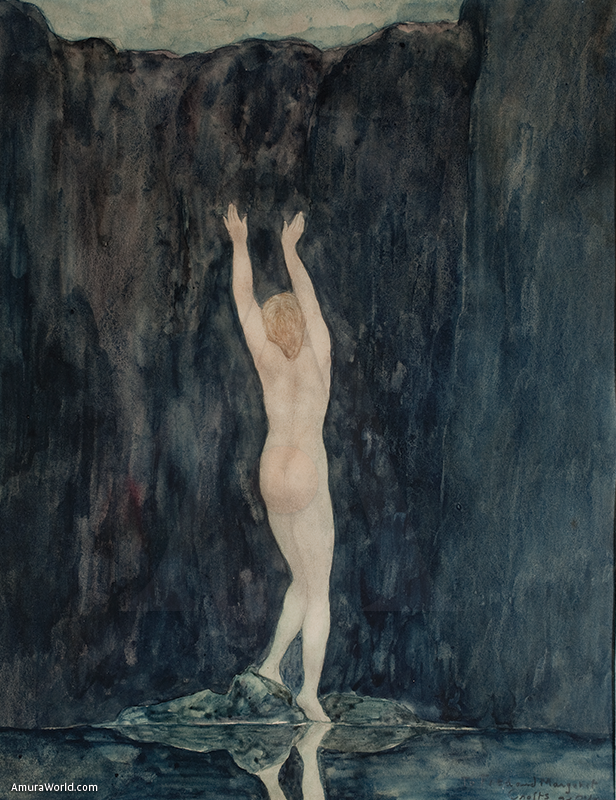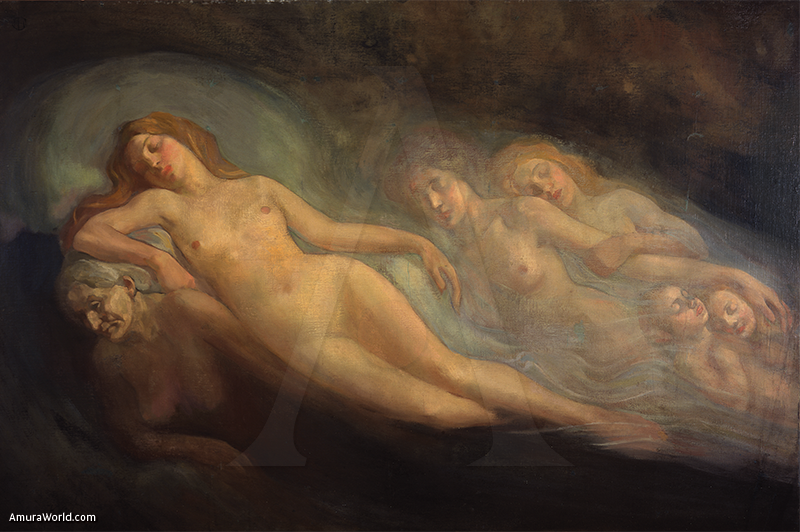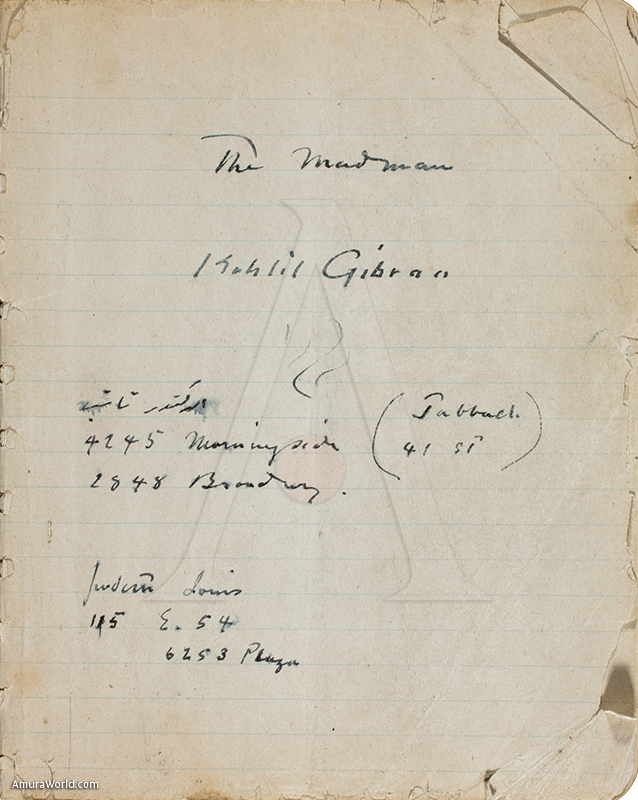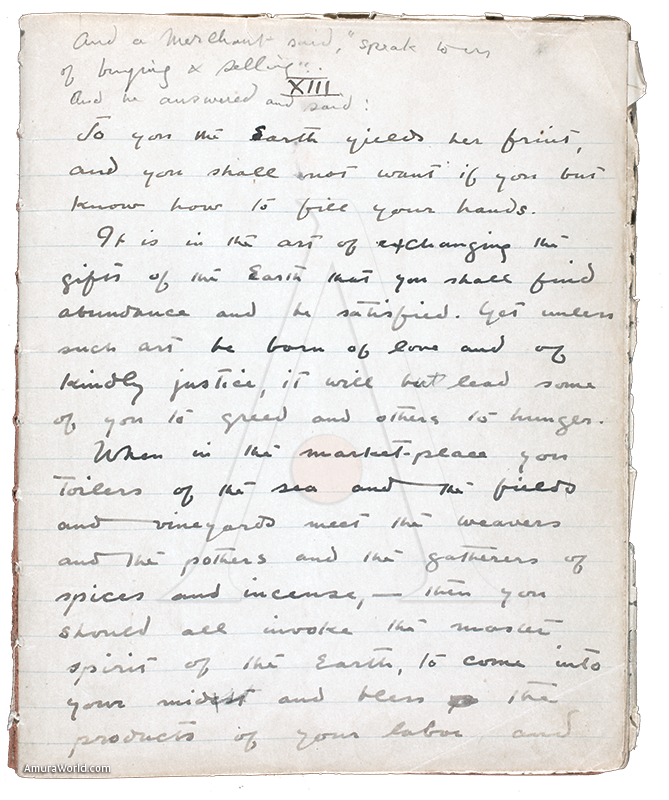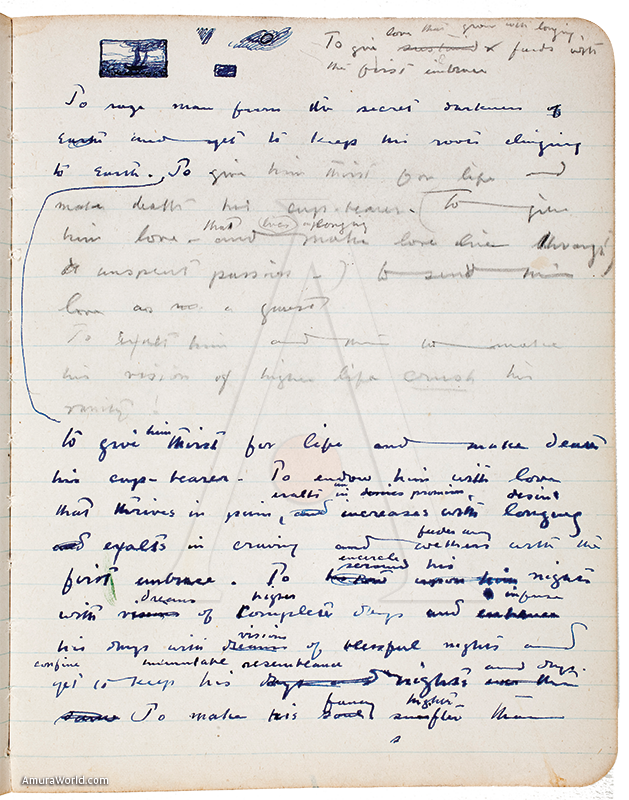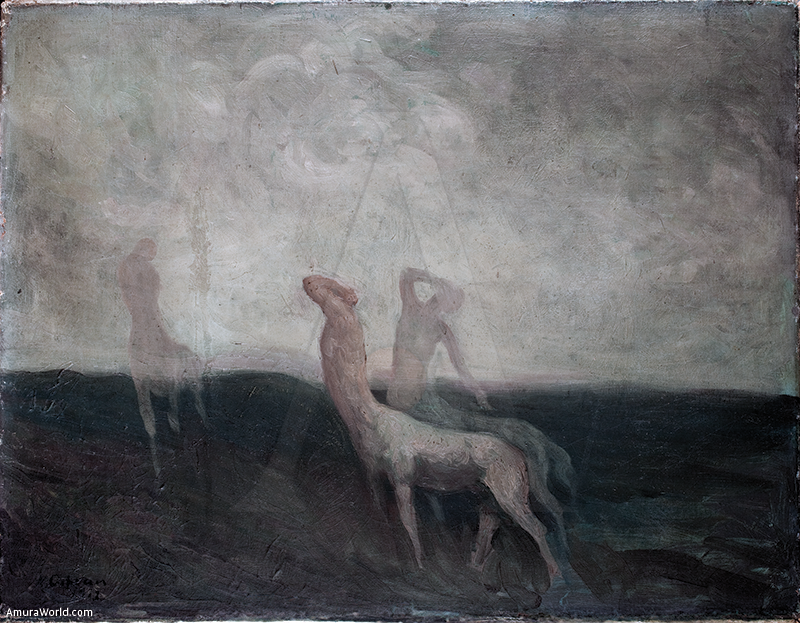… And the God of Gods separted himself from a soul and filled it with beauty.
The Soul in Tears and Smiles 1914)
In a letter from Gibran Kahlil Gibran directed to Mary Haskell, his muse and inspiration, dated in Februrary 18th 1913, the Lebanese poet wrote: “One of the most loved dreams of my heart is that, some where, in any moment, a part of my work […] will be exhibited in some museum or institution, in a great city, where people can see and perhaps love”.
The most archive of Gibran Kahlil Gibran is located in Mexico and since 2008 it belongs to the colecction of the Museum Soumaya-Foundation Carlos Slim.
From the finest literary sensibility, certainly Gibran is the largest representative of the culture of the Middle East in the West. Essayist, cartoonist, novelist, painter, playwright, poet and universal Singer of human emotions: grief, joy, love, pain, searching, loneliness and nothingness, as well as essential aspects of life. His biography and research texts create bridges between the work of Gibran and new generations. Unison for the Lebanese community and a point of encounter for a plural and inclusive view.
The exile
In the ancient millenary cedars of Becharre, Gibran Kahlil Gibran was born on January 6, 1883. Son of a tax collector Kahlil Gibran Saad Kamileh and Rahme, the child grew up in a Maronite bosom. The difficult situation following the imprisonment of his father forced the family to leave the bled. The exile the Lebanese tradition would carry him across the Atlantic.
Kamileh, of 40 years of age, and four children: Boutros 20, Marianna 9, Sultana 7 and Kahlil Gibran of 11, landed on June 17, 1895 at Ellis Island across the bay from New York. They left Beirut as a result of the harship caused by the Ottoman Empire, which dominated in all political, economic and social aspects of the Middle East, to begin a new life in the United States.
Important personalities of culture in Boston (as photographer and publisher Fred Holland Day and the writer Josephine Preston Peabody) marked the career of young Gibran. His work realizes nostalgia for Lebanon and a new life in America, as well as happiness in the family, the great loves of Gibran: his friend and patron Mary Haskell, the beautiful writer Josephine Preston Peabody, pianist Gertrude Barrie, the Micheline sensuous, Adele Watson’s creative and always devoted Barbara Young, who was his partner until his death in 1931.
Also, 20 years of correspondence with the Egyptian writer May Ziadeh, who he never met personally, but their passion would lead to the rebirth Arabic letters. The anguish of the invaded country resulted in the rescue and protection of Lebanese culture through Pen League (Al-Arrabitah) along with other artists in exile, in conjunction with those who promoted the creation of Greater Lebanon in 1920.
The philosophical quest in human affairs resulted in his great works: The Music (1905), The Fool (1918) and The Prophet (1923), plus Rebellious Spirits (1908), Broken Wings (1912), Tears and smiles (1914), the Procession (1918), the precursor and The Tempest (1920), Sand and Foam (1926), Jesus, the Son of Man (1928), and his last work which took place in the year of his death: the gods on Earth (1931), in addition to other posthumous publications among which are: The Tramp (1932), The Garden of the Prophet (1933), Nymphs of the Valley (1948) and The Voice of the Teacher (1959).
Gibran explored the world of painting and drawing since 1904 in Boston. Thanks to the financial support from Mary Haskell, the artist had in 1908-1910 a voyage in Paris. His oil paintings, all together take the Symbolist tradition of William Blake, Henri-Jean Guillaume Martin and Eugène Carrière. Strong colors that highlight the meaning of dreams. Pastel nebulae sought to recreate the atmospheres in which centaurs ride away into the distance, and where heaven and earth play to touch on a marvelous horizon.
The Soumaya Museum collection - Carlos Slim Foundation includes oil paintings, drawings, self portraits, photographs, sketches, manuscripts, first editions, typescripts of the publisher Alfred Knopf, and personal items.
The largest collection of his art work and literary pieces was guarded for decades by his nephew, godson and namesake Kahlil Gibran, who after traveling around the world enriched the archive through auctions and private collections. His goal was to open a museum dedicated to the poet in the United States. Kahlil offered the Carlos Slim Foundation the archive for it to be classified and studied in Boston and Mexico by researcher Patricia Jacobs Barquet. Today, that dream is fulfilled in the Soumaya Museum. After a process of digitalization, also shared universally through the Internet at www.gibrankgibran.org.
The first manuscripts of “The Prophet” and “The Fool”, as well as unpublished works as Banshee dramatic texts and “The unseen man”; epistolary relationship between Gibran and Gertrude Barrie; personal objects such as the first sketchbook that survived all exiles, the cane in times of the Great Depression in his hideout guarded arak, or his death mask... enable new readings of the Lebanese thinker. His work and legacy are not exhausted. They embrace identity and give coordinates. In the words of Gibran: The entire earth is my homeland and all the human race is my tribe.
The Soul
…And the God of gods separated from himself a soul
And granted it with beauty.
And gave it the softness of the morning breeze, the aroma of the flowers, the purity of the light.
And gifted it with a glass filled with joy and said: “Drink from it only when you forget the past and waste the future”; then, a glass of sorrow, and said:
“You will drink from this to know the happiness of life”.
And in it put love, which at the first wisp of
satisfaction is gone, and sweetness, which at the first word of arrogance, also fades.
And poured in it divine wisdom to conduct it
through the path of truth, and in its deepness deposited
a conscious so it could see the invisible.
And created a sentiment that roams with the shadows and walks with the wraiths.
And dressed it of longings, woven by the angels with the colors of the rainbow.
After, it put in it the obscurity of doubt
which is the shadow of the light.
And God took the fire of the forge of rage and the wind
of the desert of ignorance, and the sand of the beach
from the ocean of egoism, and the dust of the centuries, and kneaded Mankind.
It granted it with a blind strength which reveals with
madness and quiets with satisfied wishes.
Later, it gave it life which is the shadow of death.
And the God of gods smiled and weeped, and feeling
love and infinite mercy for Men, bonded body and soul. O
Gibran Kahlil Gibran “Selected Work”. The Soul in “Tears and Smiles” (1914), translation and biography of Leonardo S. Kaim.
Text: Alfonso Miranda Márquez Director General de Museo Soumaya – Fundación Carlos Slim / Héctor Palhares Dos Santos Meza - Curador de Museo Soumaya ± Photo: Museo Soumaya

